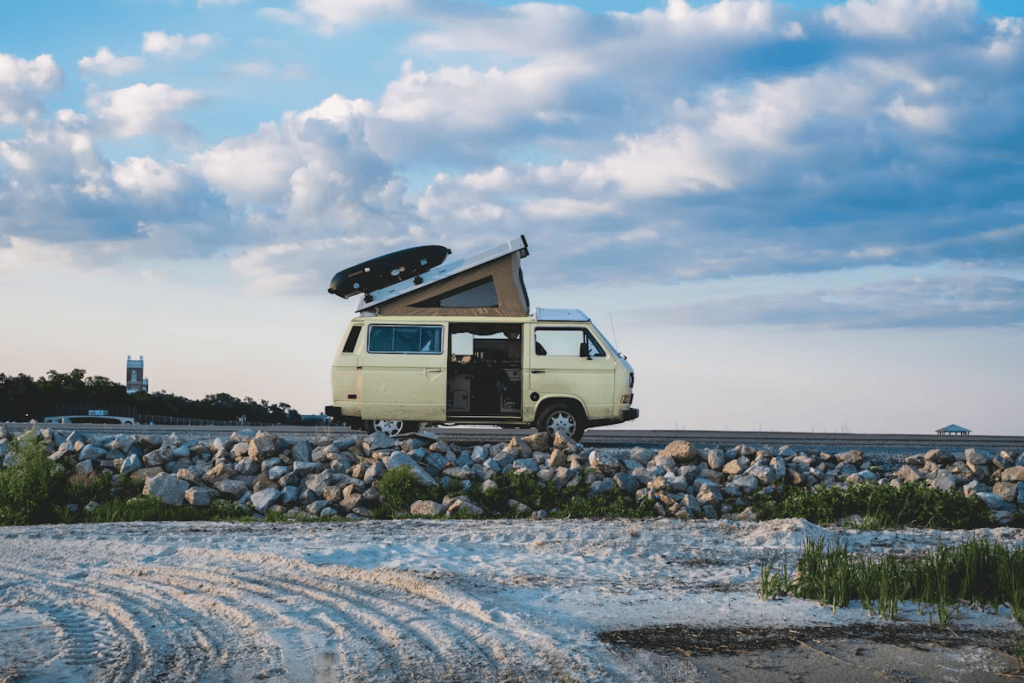Campervan travel brings together the thrill of hitting the open road with the simple pleasures of a cosy home—just on wheels. It’s a winning choice for those who fancy long road trips, allowing you to take off at your own pace, make pit stops wherever you like, and skip the hassle of fixed accommodation bookings.
The stripped-back lifestyle is part of the charm, making it easy to get around while keeping things homely. But, the real trick is making it affordable from the start.
Travel by campervan is often cheaper than conventional holidays, but a thoughtful approach is crucial for keeping costs under control. Upfront expenses for the van itself, plus ongoing outlays for maintenance and fuel, can quickly add up if you’re not careful.
Luckily, there are plenty of smart ways to save money, such as staying at free or budget campsites, doing your own repairs, and making thrifty decisions day-to-day. Keeping things minimal not only helps manage your spending and storage, but it also means less clutter and more freedom to enjoy the journey.
Cost-Effective Campervan Setup
Turning your everyday van or minivan into a campervan doesn’t have to drain your savings. A bit of clever thinking goes a long way in setting up a space that keeps you comfortable on your travels without splashing too much cash. Instead of transforming the van for good, prioritise those bits that truly matter: sleeping, storage, basic cooking, and a dash of privacy.
Sleeping always comes first. For the simplest setup, you can remove the middle seats and fold down the backs—this makes room for a few people to stretch out. Fancy a bit more comfort or need to fit five? Stack up with KID-O-BUNK youth cots, which take full advantage of the space above the floor. They cost between $278.99 and $349.99, depending on your taste and colour, but make sure you measure before you buy. To keep everyone from feeling every lump in the floor, Wakeman sleeping pads, at about $20 each, do the job nicely and are easy to stow.
Staying tidy in a compact van is half the battle. The Kid-O-Bunk Footlocker (£52) slides under the cots and keeps clothes, snacks, and gear from sprawling everywhere. If there’s a longer journey in your diary, a hanging organiser adds more space for extra bits without using up valuable floor space.
Basic cooking is easy to keep low-cost. You might start with no-cook meals or dishes that just need hot water. If you want a warm dinner, a single-burner propane stove (about $32.99) is all you need. For those days you’d rather not even bother with cooking, tossing in a few ready meals works perfectly.
For privacy and a more restful snooze, stick-on blackout film or homemade foam sheet covers can block the light—both are manageable for less than a few pounds. Foam sheets cost only about £1.20 for both sides, making it an easy fix for a good night’s sleep.
If you’re planning to camp away from official sites, a portable toilet is handy, especially for families or anyone who finds it hard to nip into the woods. It’s a simple addition that saves a lot of bother and doesn’t take up much room.
All together, these affordable swaps mean you can get your minivan road-ready for under $400. It’s a practical way to chase adventure and enjoy the open road without emptying your wallet.
Saving on Camping and Overnight Stays

Finding low-cost camping spots is a real game changer for cutting down your travel expenses. Handy apps like iOverlander, Campendium, The Dyrt, Park4Night, and Freecampsites.net are favourites among folks on the road. These tools are packed with up-to-date details about places where you can stay without spending a fortune—and sometimes for free—in all sorts of locations. Using them means you can skip pricey hotels or busy campgrounds, and snag a spot that fits your budget.
There are loads of alternative ways to sleep cheaply, too. National Forests and Bureau of Land Management (BLM) public lands in the US offer huge spaces where you can pitch up for little or nothing at all. Most National Forests allow “dispersed camping”, which just means camping outside of the organised sites, so you get more space and peace, as well. BLM areas are also known for being forgiving about overnight parking, and usually don’t charge a penny. These options are excellent for anyone wanting to spend more time in wild places and less money for the privilege.
Taking advantage of all these free and budget-friendly options lets you hold on to your hard-earned cash and adds a good bit of flexibility to your road trip plans.
Fuel Efficiency and Vehicle Maintenance Hacks
Keeping your campervan running well and getting the most out of every tank of fuel isn’t just about saving cash—it means fewer headaches on the road, too.
Start with how you drive. Easy does it on the pedal: avoid stomping on the accelerator or slamming the brakes. This alone can stretch your fuel much further, sometimes boosting your economy by up to 40%. Sticking to speed limits and ditching heavy roof cargo or excess baggage helps, too. Every unnecessary kilo you haul means more trips to the pump.
A bit of planning goes a long way. Before setting off, check your route to pick the shortest and least congested way to get there. Apps that track live traffic can save you both fuel and time—less sitting in jams, more moving forward.
Taking care of your van doesn’t need a mechanic on speed-dial. Swapping out your oil and filters, changing wiper blades, or popping in a new air filter are all jobs you can do with just a few tools at home. Many auto part shops will even lend you tools if you’re missing something. Looking after these basics means fewer big repairs down the line and keeps your vehicle running smoothly—which is key for fuel savings.
A little effort spent now puts money back in your pocket and helps you avoid surprises later on. It’s smart, simple, and makes every journey a bit easier.
Budget-Friendly Cooking and Food Preparation
If you want to get serious about saving money on the road, a bit of thoughtful meal planning goes a long way. Start by jotting down ideas that use whatever’s in season or on special at the supermarket—these are usually friendlier on your wallet. Drawing up a rough menu for the week before you shop helps you dodge those sneaky impulse splurges, and keeps the food waste to a minimum.
Cooking bigger batches is your friend here. Whip up a large pot of chilli or stew, pop the leftovers in containers, and you’ve got lunches or dinners sorted for the next few days. This is perfect for those nights when you just can’t face another expensive takeaway. Go for simple recipes using long-lasting basics like rice, pasta, and lentils—these are cheap to buy, easy to store, and endlessly versatile. Ingredients that slot into lots of dishes, like potatoes or chicken, stretch your spending even further and keep things interesting.
You can also take advantage of public barbecues and cooking spots, often dotted around parks, beaches, and some campsites. Using these facilities means you save on your own van’s gas or power, and while you’re at it, you might find yourself swapping stories or tips with other travellers. It’s a win for your budget and your social life.
Buying certain foods in bulk also helps bring the cost down. Stock up on pantry staples like tinned beans or packets of pasta if you spot a bargain, and store them in airtight containers to keep them fresh for ages. Planning ahead this way means you’re less likely to fork out on overpriced groceries in remote spots.
With a bit of preparation and a willingness to use shared spaces, you’ll find you can keep your meals both affordable and satisfying—making more room in the budget for the truly fun stuff.
Minimising Clutter and Maximising Storage
Packing minimally is crucial in a campervan, since space is at a premium and no one wants to trip over a mountain of stray shoes or jackets. Focusing on the essentials keeps things tidy and makes life on the road far more relaxed. By picking your must-haves carefully, you leave yourself with less to keep track of and more room to stretch out. If you plan your outfits ahead, and stick to items you can wear more than once, it’s amazing how much space you’ll save.
Staying organised takes a bit of creativity, but it pays off quickly. Hanging organisers, particularly the sort meant for shoes, are perfect for using vertical space—tuck them on doors or walls to stash not just shoes, but toiletries or kitchen bits too. Collapsible gear, like foldable chairs, tubs, or Tupperware, is ideal; use them when you need and flatten them away when you don’t. Everything is easier when it doesn’t compete for elbow room.
If you’ve still got a bit too much to squeeze in, try packing soft items like extra clothes or towels into your cushions. Turning your cushions into secret storage makes clever use of every nook, with the bonus of freeing up your cupboards for other things. Making small adjustments like these transforms a cramped van into a comfortable, mess-free space where you can genuinely enjoy your travels.
Enhancing Comfort on a Budget
Getting comfortable in a campervan doesn’t have to come with a hefty price tag, especially if you mix a bit of smarts with your setup. Start by sorting out the sleeping arrangements. KID-O-BUNK youth cots make clever use of the space above the floor, letting two kids bunk up off the ground. Meanwhile, others can stretch out on Wakeman sleeping pads, which sit directly on the floor and smooth out any awkward bumps—costing around $18–$20 each, they’re an easy fix for sore backs.
Keeping warm is a top priority if your adventures stretch into cooler weather. Compact sleeping bags from Cascade Mountain Tech pack a decent punch when it gets chilly, without taking over your storage. For privacy and better sleep, cut-to-size foam sheets hung over the windows do the job by blocking out light, and you can put together a set for as little as £1.20.
With weather that can swing from stifling to brisk, it pays to pack a variety of bedding. Light blankets are those quiet heroes on warm nights, but when temperatures dip, having extra layers makes all the difference. On hot days, a portable fan or some simple window screens can help keep air moving while keeping insects out, which is especially important for improving air circulation in your caravan.
Dealing with damp is another must. Quick-dry towels serve double duty: they get you dry after a wash and help wipe up any moisture inside the van, which stops the nastier stuff like mould from having a field day. Keeping the windows open when you can, or running a small battery fan, helps keep air crisp and condensation at bay.
Affordable tweaks and a bit of common sense go a long way in making your campervan adventures far more enjoyable, all while sticking to your budget.




